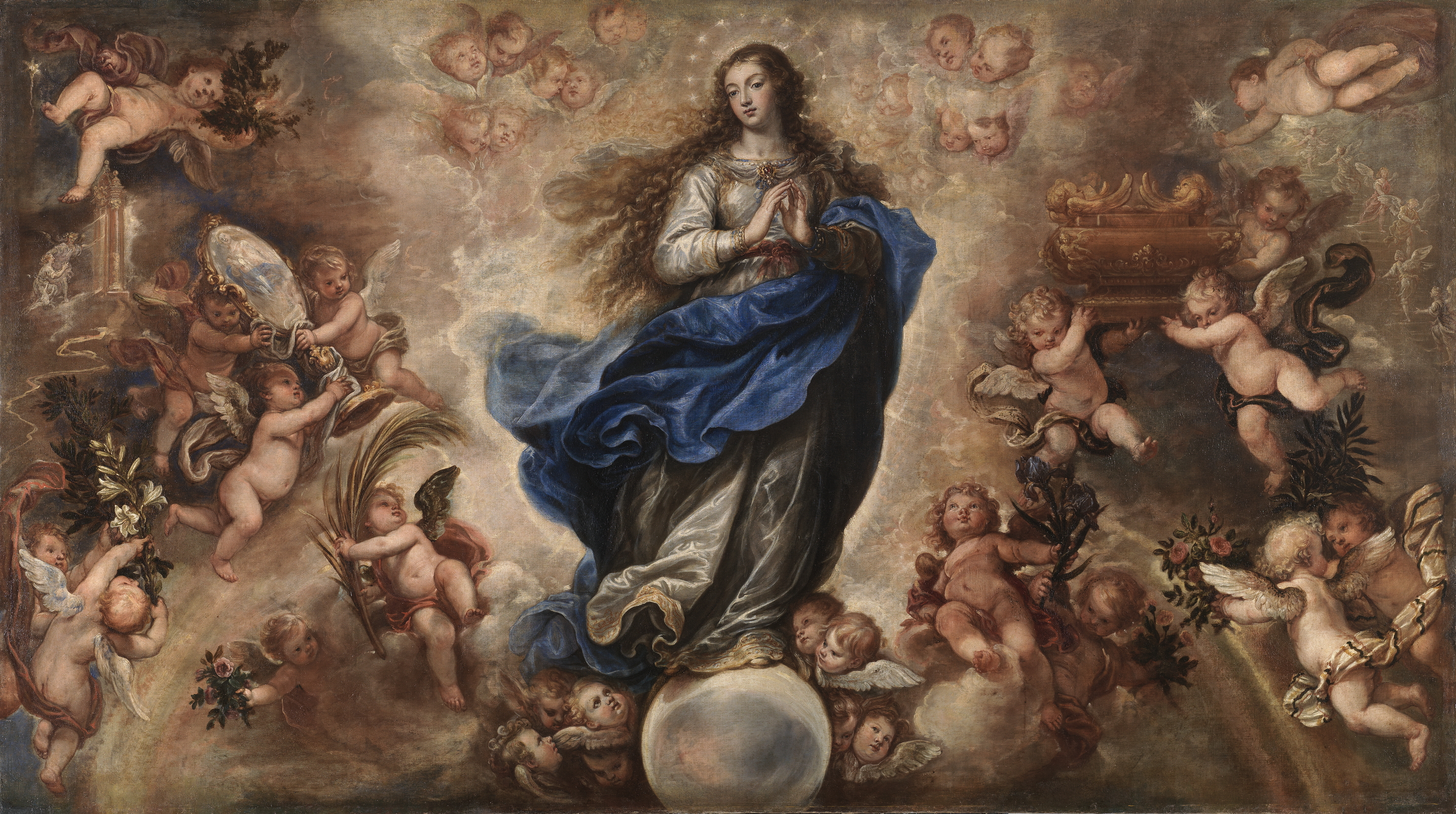What is the Feast of the Immaculate Conception?

By Francisco Rizi - [3], Public Domain, Link
Chapter Text
The Solemnity of the Immaculate Conception celebrates the Immaculate Conception of the Blessed Virgin Mary on 8 December, nine months before the feast of the Nativity of Mary on 8 September. It is one of the most important Marian feasts in the liturgical calendar of the Roman Catholic Church.
By pontifical decree, it is the patronal feast day of Argentina, Brazil, Chile, Italy, Korea, Nicaragua, Paraguay, the Philippines, Spain, the United States, and Uruguay. By royal decree, it is designated as the day honoring the patroness of Portugal.
Since 1953, the Pope visits the Column of the Immaculate Conception in the Piazza di Spagna to offer expiatory prayers commemorating the solemn event.
The feast was solemnized as a holy day of obligation on 6 December 1708,[1] by the papal bull Commissi Nobis Divinitus of Pope Clement XI.[2][3][4] It is celebrated with Masses, parades, fireworks, processions, food and cultural festivities in honor of the Blessed Virgin Mary in Catholic countries.
HISTORY
The Eastern Church first celebrated a Feast of the Conception of the Most Holy and All Pure Mother of God on 9 December, perhaps as early as the 5th century in Syria. The original title of the feast focused more specifically on Saint Anne, being termed Sylepsis tes hagias kai theoprometoros Annas ("conception of Saint Anne, the ancestress of God").[5] By the 7th century, the feast was already widely known in the East. However, when the Eastern Church called Mary Achrantos("spotless", "immaculate"), this was not defined doctrine.
Most Orthodox Christians reject the Scholastic definition of Mary's preservation from original sin, a concept later defined in the Western Church post the Great Schism of 1054.[6] The feast associated with her immaculate conception, initially celebrated on 8 December, was translated to the Western Church in the 8th century. It then spread from the Byzantine Southern Italy to Normandy during the Norman dominance, eventually reaching England, France, Germany, and Rome.[7]
In 1568, Pope Pius V revised the Roman Breviary, and though the Franciscans were allowed to retain the Office and Mass written by Bernardine dei Busti, this office was suppressed for the rest of the Church, and the office of the Nativity of the Blessed Virgin was substituted instead, the word "Conception" being substituted for "Nativity".[8]
According to the papal bull Commissi Nobis Divinitus, dated 6 December 1708, Pope Clement XI mandated the feast as a holy day of oligation which is to be celebrated in future years by the faithful.[9]Furthermore, the pontiff requested that the papal bull be notarized in the Holy See to be further copied and reproduced for dissemination.
Prior to Pope Pius IX's definition of the Immaculate Conception as a Roman Catholic dogma in 1854, most missals referred to it as the Feast of the Conception of the Blessed Virgin Mary. The festal texts of this period focused more on the action of her conception than on the theological question of her preservation from original sin. A missal published in England in 1806 indicates the same collect for the feast of the Nativity of the Blessed Virgin Mary was used for this feast as well.[10]
The first move towards describing Mary's conception as "immaculate" came in the 11th century. In the 15th century, Pope Sixtus IV, while promoting the festival, explicitly tolerated both the views of those who promoted it as the Immaculate Conception and those who challenged such a description, a position later endorsed by the Council of Trent.[5]
The proper for the feast of the Conception of the Blessed Virgin Mary in the medieval Sarum missal merely addresses the fact of her conception. The collect for the feast reads:
O God, mercifully hear the supplication of thy servants who are assembled together on the Conception of the Virgin Mother of God, may at her intercession be delivered by Thee from dangers which beset us.[11]
ROMAN CATHOLIC CHURCH
Pope Pius IX on 8 December 1854 issued the apostolic constitutionIneffabilis Deus:
"The most Blessed Virgin Mary, in the first instant of her conception, by a singular grace and privilege granted by almighty God, in view of the merits of Jesus Christ, the saviour of the human race, was preserved free from all stain of original sin."[12]
According to the Universal Norms on the Liturgical Year and the Calendar, the solemnity of the Immaculate Conception cannot replace an Advent Sunday; if 8 December falls on a Sunday, the solemnity is transferred to the following Monday.[13] (In some countries, including the United States, the obligation to attend Mass does not transfer.)[14] The 1960 Code of Rubrics, still observed by some in accordance with Summorum Pontificum, gives the feast of the Immaculate Conception preference even over an Advent Sunday.[15]
ORIENTAL ORTHODOXY
The Ethiopian Orthodox Tewahedo Church celebrates the Feast of the Immaculate Conception on Nehasie 7 (August 13). The 96th chapter of the Kebra Nagast states: "He cleansed Eve's body and sanctified it and made for it a dwelling in her for Adam's salvation. Mary was born without blemish, for He made Her pure, without pollution".[17]
EASTERN ORTHODOXY
The Eastern Orthodox Churches does not accept the Roman Catholic dogma of the Immaculate Conception. Accordingly, they celebrate 9 December called the “Feast of the Conception by Saint Anne of the Most Holy Theotokos”.
While the Orthodox believe that the Virgin Mary was, from her conception, filled with every grace of the Holy Spirit, in view of her calling as the Mother of God, they do not teach that she was conceived without original sin as their understanding and terminology of the doctrine of original sin differs from the Roman Catholic articulation.[18] The Orthodox do, however, affirm that Mary is "all-holy" and never committed a personal sin during her lifetime.[19]
The Orthodox feast is not a perfect nine months before the feast of the Nativity of the Theotokos (8 September) as it is in the West, but a day later. This feast is not ranked among the Great Feasts of the church year, but is a lesser-ranking feast (Polyeleos).
DESIGNATION AS PUBLIC HOLIDAY
The solemnity is a registered public holiday in the following sovereign countries and territories:
- Andorra
- Argentina
- Austria
- Chile
- Colombia — its people cook food and delicacies honoring this day.
- Equatorial Guinea
- Guam (USA)
- Italy — it has been a national holiday since 1953. The Pope, in his capacity as Bishop of Rome, visits the Column of the Immaculate Conception in Piazza di Spagna to offer expiatory prayers commemorating the solemn event. The day marks the start of the Christmas season in the country.[20]
- Liechtenstein
- Macau, China — by Government Executive Order No. 60/2000, published on 29 September 2000 and enforced into legal effect since 1 January 2001.[21]
- Malta
- Monaco — it is celebrated with food festivities, particularly honoring mothers and grandmothers.
- Nicaragua – the solemnity is celebrated with local parades and religious processions.
- Panama – it is celebrated throughout the country as Mother's Day.
- Paraguay
- Peru
- Philippines – the day is designated as a non-working public holiday in honor of the Virgin Mary as Patroness of the country and was permanently signed into constitutional law as holiday on 28 December 2017 by the Government of the Philippines.[22]
- Portugal
- San Marino
- Seychelles
- Spain — since 8 November 1760, the day is marked as a national holiday as designated by Pope Clement XIII.
- Switzerland — at present, 13 out of 26 cantons have elected to make this is a registered public holiday in accordance with government laws.[23]
- East Timor
- Vatican
- Venezuela
See also
Notes
- Clementis XI, Papam - CXX - Mandatur ut Festum Conceptionis beatae Mariae Virginis Immaculatae de praecepto ubique observetur - Commissi Nobis Divinitus sacrosancti apostolatus officii exigit ratio, ut gloriossimae Virginis Dei genitricis Mariae cuius Conceptio gaudium annuciavit universo mundo, venerationem et cultum, plurium Romanorum Pontificum praedecessorum nostrorum more, ampliare studentes in terris, illius, quae super choros angelorum exaltata pro populo Christiano sedula exoratrix apud eum, quem genuit, assidue intercedit in caelis, potentissimam opem in toltantisque, quibus premimur, Christianae reipublicae et Catholicae Ecclesiae necessitatibus, quantum nobis ex alto conceditur, promereri iugiter satagamus. Datum Romae, apud Sanctum Petrum, sub annulo Piscatoris, die 6 Decembris 1708 Pontificatus Nostri Anno IX. - http://www.icar.beniculturali.it/biblio/pdf/bolTau/tomo_21/02_T21_189_368.pdf Archived 2013-12-14 at the Wayback Machine (PP. 338)
- Lacoste, Jean-Yves (29 September 2004). Encyclopedia of Christian Theology. Taylor & Francis. ISBN 9780203319017.normal
- "Introduction". Archived from the original on 18 February 2012.normal
- Gentle, Judith Marie; Fastiggi, Robert L. (30 September 2009). De Maria Numquam Satis: The Significance of the Catholic Doctrines on the Blessed Virgin Mary for All People. University Press of America. ISBN 9780761848479 – via Google Books.normal
- ^ a b "CATHOLIC ENCYCLOPEDIA: Immaculate Conception". www.newadvent.org.normal
- Timothy Ware (Bishop Kallistos). The Orthodox Church (London: Penguin Books, 1963), pp. 263–264.
- Francis X. Weiser. Handbook of Christian Feasts and Customs (New York: Harcourt, Brace & World, 1958), p. 292.
- "Habig O.F.M., Marion A. "Land of Mary Immaculate", The American Ecclesiastical Review, June 1954".normal
- Commissi Nobis Divinitus - VI Decembris 1708 - Clementis XI, Papam - Sincera itaque nostra erga eamdem augustissimam caeli reginam, patronam, advocatam, nostram, devotione incitati festum conceptionis ipsius beatae mariae virginis immaculatae ubique terrarum in posterum ab omnibus et singulis utriusque sexus christifidelibus sicut alia festa de praecepto observationis festorum comprehendi auctoritate apostolica, tenore praesentium decernimus praecipimus et mandamus. ...Volumus autem ut earumdem praesentium literrarum transumptis, seu exemplis etiam impressis, manu alicuius notarii publici subscriptis, et sigillo personae in ecclesiastica dignitate constitutae munitis, eadem prorsus fides adhibeatur ipsis praesentibus si forent exhibitae vel ostensae.
- The Roman Missal in English Tr. John England (Philadelphia: Eugene Chummiskey, 1843), p. 529.
- The Sarum Missal in English Tr. A. Harford Pearson (London: The Church Printing Co., 1834), p. 332.
- Ineffabilis Deus the Apostolic Constitution of Pope Pius IX on the Immaculate Conception (8 December 1854), in the Acta Pii IX, pars 1, Vol. 1, p. 615.
- Universal Norms on the Liturgical Year and the Calendar No. 5.
- Edward McNamara, "Feast of the Immaculate Conception", ZENIT, 17 December 2013.
- Code of Rubrics, 15
- "The Calendar [page ix]". Archived from the original on 4 November 2013. Retrieved 3 November 2013.normal
- "THE BIRTH OF THE BLESSED VIRGIN MARY – Ethiopian Orthodox Tewahedo Church Sunday School Department – Mahibere Kidusan".normal
- Timothy Ware, The Orthodox Church (Penguin Books, 1963, ISBN 0-14-020592-6), pp. 263-4.
- "The Sinlessness of the Theotokos". Monastery of St. Tikhon of Zadonsk. Archived from the original on 12 July 2020. Retrieved 12 July 2020.normal
- Donati, Silvia (25 November 2021). "Celebrate Christmas Like an Italian". Italy Magazine.normal
- Exec. Order No. 60/2000 (September 29, 2000; in Traditional Chinese) Chief Executive of Macau
- Republic Act No. 10966 (28 December 2017), An Act Declaring December 8 of Every Year a Special Nonworking Holiday in the Entire Country to Commemorate the Feast of the Immaculate Conception of Mary, the Principal Patroness of the Philippines, Official Gazette of the Republic of the Philippines, retrieved 9 December 2023normal
- "Earth Calendar". www.earthcalendar.net.normal
Quiz
Review the questions and verify your answers by clicking the tab.
When is the Feast of the Immaculate Conception celebrated?
December 8, unless December 8 falls on a Sunday, then it is moved to Monday.
Do all Christians celebrate the Feast of the Immaculate Conception on the same day?
No. Some Orthodox celebrate it on December 9. Ethiopian Orthodox celebrate it on August 13.
Do all Christians believe that the Virgin Mary was born without sin?
Not exactly. Orthodox Christians do not use the term Immaculate. However, they do believe the Virgin Mary remained sinless her entire life.




